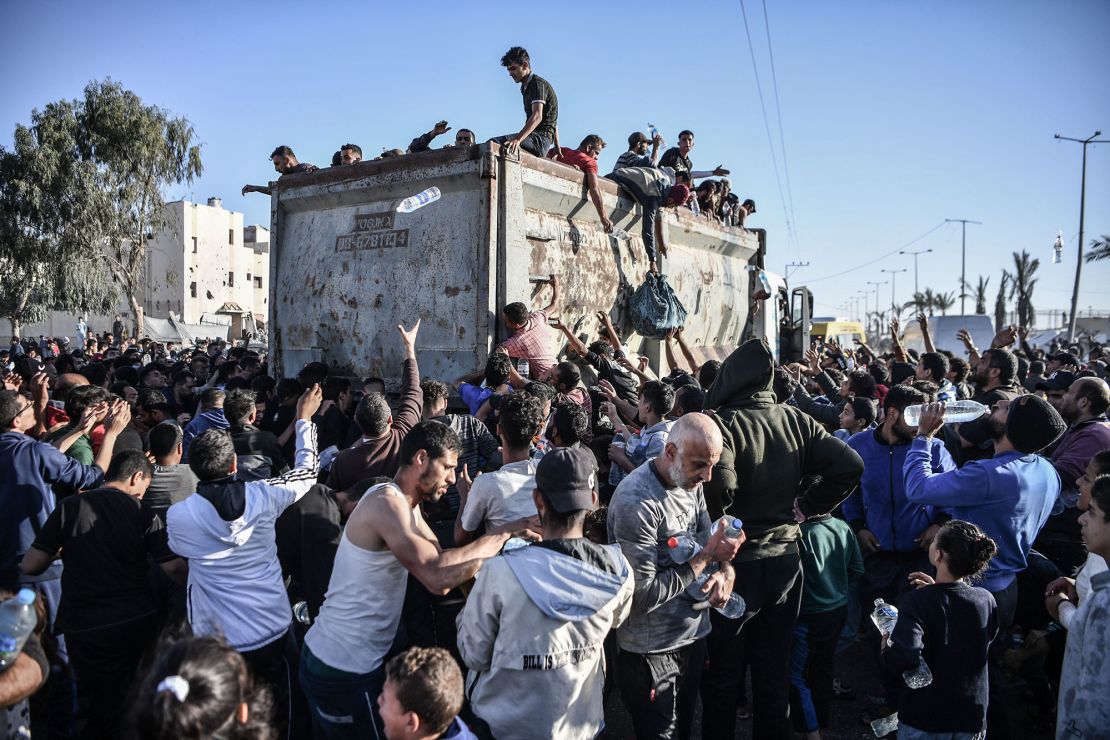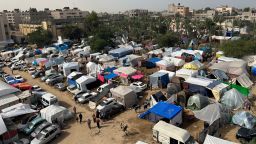Bloody diarrhea, jaundice, acute hepatitis and respiratory infections. These are just some of the diseases spreading in the Gaza Strip, where the World Health Organization (WHO) says the health system is “on its knees and collapsing.”
As the war between Israel and Hamas enters its third month, medics and aid groups are sounding alarm bells on the humanitarian situation in the besieged enclave – where the United Nations is worried that more people may end up dying of diseases than from bombs and missiles.
The coastal territory – which the Hamas militant group controls – has been under complete siege by Israel since the beginning of Israel’s war with Hamas, when the Palestinian group launched an October 7 attack on Israel, killing 1,200 people and kidnapping 240 others, according to Israeli authorities.
Most of the Strip has run out of food, potable water, electricity and medical supplies as hundreds of thousands of displaced Palestinians crowd into small spaces to shelter from Israel’s bombs.
Apart from foreign nationals and a small number of injured Palestinians, almost no one has been able to escape Gaza, where more than 2 million people remain trapped.
More than 18,000 people have been killed in Gaza since the fighting broke out, the Hamas-controlled health ministry in the enclave said Monday.
Here’s what we know about the potential for disease to spread in the territory.
How has the healthcare system been affected by the war?
Local doctors and the UN have for weeks been warning of deadly outbreaks, with the WHO last month saying that the crisis in Gaza is a “recipe for epidemics.”
In remarks to WHO member countries, Director-General Tedros Adhanom Ghebreyesus on Sunday said that only 14 hospitals out of 36 in Gaza are functional, with the two main hospitals in the south operating at three times their capacity.
Only two are left operating north of Wadi Gaza, he said, which Israel had asked some 1.1 million people to evacuate south of as it began its ground operation on October 13. Just 1,400 hospital beds are left, he added, with medical facilities running out of supplies while acting as makeshift shelters for the displaced.

What diseases are medics worried about?
The WHO chief said there were worrying signals of epidemic diseases “including bloody diarrhea and jaundice,” adding that there have also been reports of high levels of diarrheal diseases and respiratory infections.
Other diseases reported in Gaza include measles, meningitis, chickenpox and acute viral hepatitis, according to the Palestinian Ministry of Health in Gaza.
Richard Peeperkorn, WHO Representative in the Occupied Palestinian Territory, on Tuesday said there are between 160,000 to 165,000 cases of diarrhea among children under the age of five, which is “much more” than in normal times.
Diarrheal diseases are believed to be the second leading cause of death in children under five years old. Left untreated, diarrhea can last several days, leaving the body without the water and salts needed for survival.
The Palestinian Ministry of Health has also reported more than 133,000 cases of upper respiratory tract infection (URTI) – a viral infection that can affect the nose, throat and sinuses – more than 17,000 cases of lice and nits, some 35,000 cases of skin rashes and more than 1,900 cases of food poisoning.
The ministry has not reported any cases of cholera, but Médecins Sans Frontières (MSF), also known as Doctors Without Borders, has repeatedly warned of a potential cholera outbreak amid a lack of clean water in overcrowded areas.
“Many are drinking salty or contaminated water, which can make people sick,” MSF said in October.
Cholera has spread during wars in Yemen, Syria and Sudan in recent years.
Euro-Med Human Rights Monitor warned last month that bodies near or in water sources may also lead to contamination, increasing the risk of cholera and other gastrointestinal diseases.
Other diseases, including blood-borne viruses and tuberculosis, may result from the public decomposition of dead bodies for long periods of time, a common occurrence amid the war in Gaza.
What’s causing the diseases and why are they spreading?
After Israel imposed a blockade on Gaza on October 9, the enclave quickly began running out of food and drinking water. Fuel supplies have dwindled, leaving the population with little to no electricity to power medical facilities, refrigerate food or even store bodies killed in the fighting.
Israel is now expanding its military operation deeper into southern Gaza, telling civilians to evacuate areas they had moved to following the military’s call to evacuate the north.
Almost all of Gaza’s population – 1.9 million out of the more than 2 million in the enclave – is now displaced, the WHO said Sunday.
There are few places to move to, and hundreds of thousands are moving into more crowded areas. The UN estimates at least 60% of Gaza’s housing has been destroyed or damaged as of November 24.

How is the international community reacting?
The UN General Assembly will on Tuesday resume its emergency session on the situation in Gaza, days after the United States vetoed a UN Security Council resolution calling for a humanitarian ceasefire.
UN staff in Gaza feel abandoned after the US veto, Philippe Lazzarini, the head of the UN Relief and Works Agency for Palestinian refugees (UNRWA) said on Monday. They “cannot understand” why a ceasefire has not been agreed on after thousands have been killed and displaced, he said in the Egyptian city of Arish, close to the Rafah crossing with Gaza.
Gaza is “very close” to seeing “a breakdown of civil order,” which will not allow the agency to operate any more, he said, noting how some civilians in Gaza have resorted to looting warehouses in desperation.
In recent days, between 60 and 100 trucks have been using Rafah crossing to enter Gaza – a volume aid groups say is too little to mitigate the territory’s humanitarian crisis.
It is unclear when more aid will make it into Gaza, but Israeli authorities said Monday that two crossings it shares with Gaza – Kerem Shalom and Nitzana – will be used to help screen humanitarian aid destined for the territory, noting that no aid will be allowed directly into Gaza from either crossing in Israel.
The aid will be screened at both crossings then forwarded from there to international aid organizations in the Gaza Strip via Rafah in Egypt, Israel said.
CNN’s Kareem Khadder, Niamh Kennedy, Clarissa Ward, Catherine Nicholls, Tamar Michaelis and Tim Lister contributed to this report.







